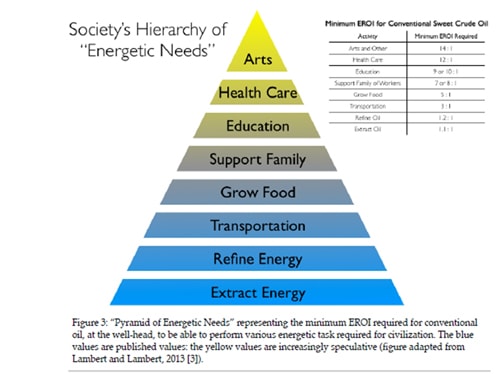EROI is a critical social metric* that reflects the ease with which energy can be produced. It is a ratio between the energy produced and the energy used in the production process.
Energy Returned on Energy Invested
In the early days of oil production from easily accessed virgin fields, it was possible to output 100 barrels of oil for every barrel of oil equivalent used in the production process. This yielded an amazing EROI of 100:1 and the resultant tidal wave of cheap energy launched world societies into realms of sophistication and learning unmatched in history.
Currently, the world average EROI for oil production has fallen to around 17:1 as the rich conventional oil fields deplete and we are forced to rely increasingly on more marginal plays like fracking and the oil sands. Solar PV is close to 8:1 and rising while wind is between 15:1 and 20:1. Biofuels barely break even at between 1:1 and 1.4:1. So why are we bothering with ethanol?
The EROI for fracking is likely between 10:1 and 15:1 whereas the oil sands EROI is a world-low of not better than 4:1. Oil, and all energy is becoming more expensive to produce, hence the great interest in fusion.
But is it indeed –
Infinite free clean energy for all!
Maybe not quite yet. “Too cheap to meter and infinite” is what nuclear power was 70 years ago. Since then reality has replaced dreams and promotion.
But at least now we have a starting point to begin to measure how likely fusion will be able to step into the huge chasm in energy supply that declining fossil fuels will leave in the next few decades.
We were waiting for data which would indicate the EROI of fusion to come out. Now we have it. Not that this is definitive but it is the first set of numbers we’ve seen that would support an EROI analysis.
From Alice Friedemann:
“ Lasers zapped a frozen hydrogen pellet with 2.05 Megajoules (MJ) of energy and 3.15 MJ came out. The net yield of 1.10 MJ is enough to boil about 10 kettles of water according to Jeremy Chittenden, co-director of the Centre for Inertial Fusion Studies at Imperial College in London.
But was more energy created in the system as a whole? Actually no, as the lasers consumed 322 MJ to generate the 2.05 MJ blast. ”
Do the math and the process EROI including the energy to power the lasers (not just the laser output) comes in at around 0.01:1, i.e. a negative return. You have to start somewhere.
The entire system EROI comes in even far lower as the energy required to create the infrastructure and apparatus would have to be included.
Nevertheless, we have a reference now against which to compare future results and system EROI will increase rapidly as Charlie Hall points out since the estimate of 5 billion MJ *** to build and house the lasers is a onetime investment.
This would mean the total energy input would be 5,000,000,322 MJ to produce the first output of 3.15 MJ.
The math: EROI = 3.15 / 5,000,000,322 or 0.000000000629 :1
And until the energy output exceeds the energy required to power the lasers, the EROI will remain negative, i.e. below 1:1.
|
Section of Process |
Energy Input Mega Joules |
Energy Output Mega Joules |
EROI |
|
Laser Energy |
2.05 |
3.15 |
1.54:1 |
|
Energy to drive lasers |
322 |
3.15 |
0.01:1 |
|
Construction of complete facility and energy to drive lasers i.e. all the energy that went into the experiment |
5,000,000,322 |
3.15 |
0.000000000629:1 |
Keep in mind that the EROI needed to support a moderately sophisticated society is at least 8:1. This varies dramatically with latitude** (energy demand to survive).
We will post the EROIs of every test for which data is available and hopefully, from this initial point, the curve will begin to rise.
*

**

Windsor, Canada’s most southerly city vs Guadalajara, Mexico
*** Charlie Hall made a crude assessment of this from the mean national energy use of 5 MJ/$, giving an estimate of 5 billion MJ to build and house the lasers. Of course this is a one time investment, so the ratio would get better with additional experiments unless they build more infrastructure. Of course that would be required for a commercial facility.

